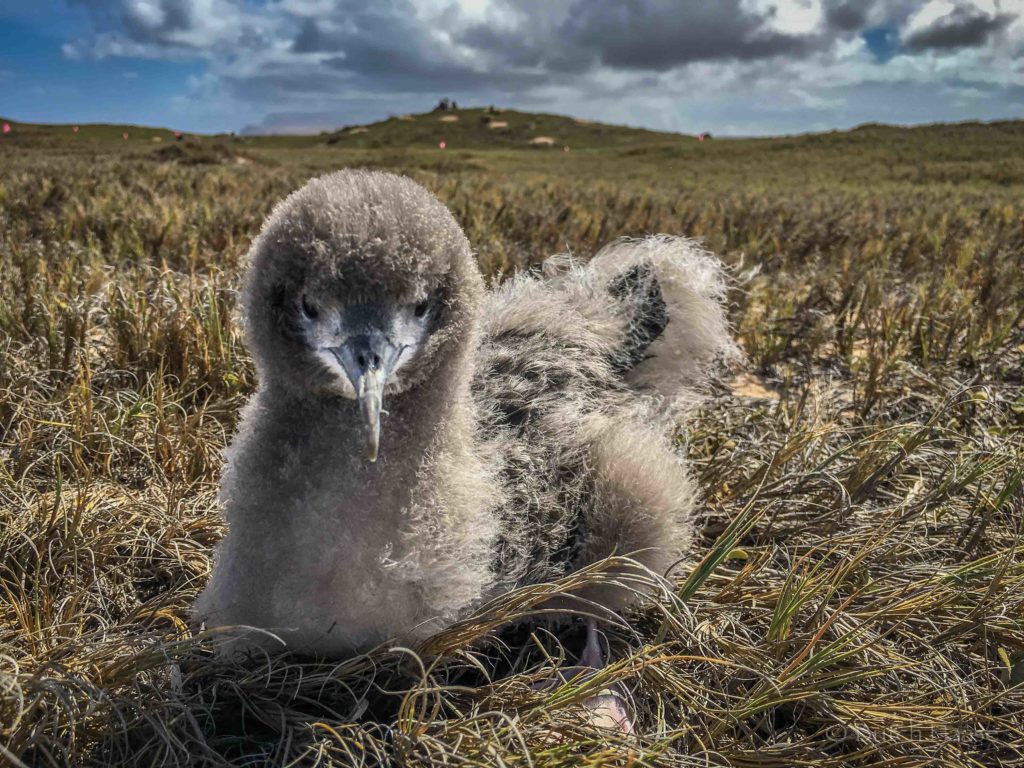Moloka‘i Wedge-tailed Shearwater Colony Now One of State’s Largest
The number Wedge-tailed Shearwaters on Molokaʻi has grown from just two nests in 1999 to nearly 1,500 nests today. Workers with The Nature Conservancy, say that with more than 3,200 birds at the Moʻomomi Preserve, the colony has grown to be one of the largest and best protected colonies in the state.

Nighttime banding of shearwater chicks: Photo courtesy of Debbie Delatour
The achievement was made by clearing acres of invasive weeds and controlling the predatory animals that threaten the shearwaters’ survival. The colony’s growth has been tracked by annual bandings of the nesting adults and their chicks.
“The fact that the wedgetails are returning to Moʻomomi tells us that the area is really healthy. Because the ecosystem is healthy, the species that are supposed to be there are returning,” said Wailana Moses, the Conservancy shearwater coordinator.

Baby shearwater chick. Photo courtesy of Butch Haase
Nature Conservancy representatives say the 923-acre Moʻomomi Preserve is a “last stronghold” of a coastal dune ecosystem that has almost disappeared from the main Hawaiian Islands. The preserve protects almost two dozen native plant species, is an important nesting site for the green sea turtle, and was once home to at least 30 bird species, about one-third of which are now extinct.
Wedge-tailed shearwaters have disappeared from many locations in the main Hawaiian Islands. Although the birds are not endangered, shoreline development and predation have driven them from their coastal homes to the safety of offshore islets. When two shearwater nests were found at Moʻomomi in 1999, it marked the first time such a discovery was made in the area in decades.
“We were excited, of course, and the following year we went out there and found 20 nests,” says Ed Misaki, the Conservancy’s Molokaʻi program director. “That’s when we decided we should start managing for the shearwaters because they were trying to establish a colony.”
The challenges were significant. A dense Axis deer population trampled nests and ate the coastal vegetation whose roots supported burrows in the sand. Loose dogs killed shearwaters in massive numbers—in one night 70 were killed by a single dog. Cats were using kiawe thickets as refuges where they brought dead birds to eat them. Mongooses and rats were additional threats.
The Conservancy launched predator control programs, pushed back the thorny kiawe to create 19 acres of new habitat, and built a 1.5-mile coastal fence to keep the animals from returning. The result is a Moʻomomi whose native residents—including birds and plants—are thriving.
“Moʻomomi is a very significant colony for the state—it’s now among the largest populations,” says Jay Penniman, project manager of the Maui Nui Seabird Recovery Project. “It’s a shining example of what you can do by just changing the habitat and removing predators—it’s a jewel.”
Nest counts at Moʻomomi have been ongoing since 2000, with the banding beginning in 2005. Led by Penniman and State wildlife biologist Fern Duvall, the bandings take place twice a year. “The main purpose of the banding is to find out more about these birds so that we can protect them better,” Moses said.
Banding of adult birds takes place one night every spring, when the shearwaters return to prepare for the nesting season and to look for or reunite with a mate. Each band is numbered, and data is entered into an international database to track species demographics. In the fall, volunteers return to monitor nesting activity. Then, in late October, they go back to band the shearwater chicks. This October, volunteers banded 239 new chicks.
Wedge-tailed shearwaters — or ʻuaʻu kani — are large, dark-brown migratory birds with a black-tipped dark-gray bill. The birds live most of all their lives at sea and come ashore only to breed, returning to the same nest site each year. Their return benefits the preserve because their droppings bring important marine nutrients back to the land. Plants become far more vigorous, reinstating ecosystem function that has been lost.
Local fishermen know wedgetail shearwaters as the “aku” bird. Out at sea, schools of akule feed on large schools of bait fish, driving them to the surface. When fishermen see the wedgetails feeding on the bait fish they know there are akule below the surface.









